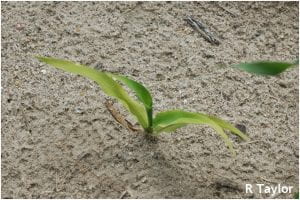Richard Taylor, Extension Agronomist; rtaylor@udel.edu
After visiting a great many fields over the past few days, I came to the conclusion that our efforts in controlling air pollution and especially sulfur (S) emissions have been very successful, perhaps too successful. The number of corn fields that are showing areas that of yellowing plants likely due to S deficiency is as great as or greater than I can ever remember seeing. I’m seeing plants with both the traditional S deficiency we all learned about in school where the plant shows a general chlorosis and stunting (Photo 1) and interveinal chlorosis that has been the hallmark of S deficiency in the past few years (Photo 2). Although many agronomists in the area were unsure of the interveinal chlorosis symptomology when it first appeared, Dr. Greg Binford did a few fertilization studies that seemed to confirm that S was responsible for the symptoms or at least could eliminate the symptoms.
Photo 1. More traditional sulfur deficiency symptom on corn with general chlorosis of the leaves and stunting of the plant which was about half the size of less affected plants.
Photo 2. Less traditional sulfur deficiency symptom on corn with severe interveinal chlorosis of the leaves along with stunting of the plant.
Many growers are already taking steps to reduce the impact of the ‘cleaner air’ by adding some ammonium sulfate to the corn starter fertilizer or to their sidedressed nitrogen (N). In Dr. Binford’s field trials, he did get a yield increase when S fertilizer was added; although in studies a number of years ago, I didn’t find a yield response to added broadcast S fertilizer. In many cases as the corn root system continues development, it is able to pick up S from the deeper soil layers and the deficiency symptoms disappear on their own accord. Another complication in the story is that we have changed from using the old superphosphate fertilizer (rock phosphate treated with sulfuric acid to make a 0-20-0 fertilizer) to new formulations, MAP, DAP and ammonium polyphosphates. This change has reduced the amount of S we were adding to our soils without consciously realizing it. I think as we go forward more and more growers will be using ammonium sulfate at some point in their cropping rotations to add needed sulfur to the topsoil.
You should keep in mind that S is either in an anion (negatively charged ion) form (SO42-) or is rapidly converted in warm, moist soil to the anion sulfate form. Anions such as sulfate and nitrate are subject to leaching loss from the topsoil. Dr. Tom Sims did find large quantities of sulfate in the deep subsoil layers of even the sandy soils in Sussex County, Delaware but the corn and other crops are not able to obtain S from these layers until much later in the growing season when the root system is nearly fully established. Early in the season, we are likely to find more and more fields showing S deficiency unless S fertilizer is regularly applied to the crops.


